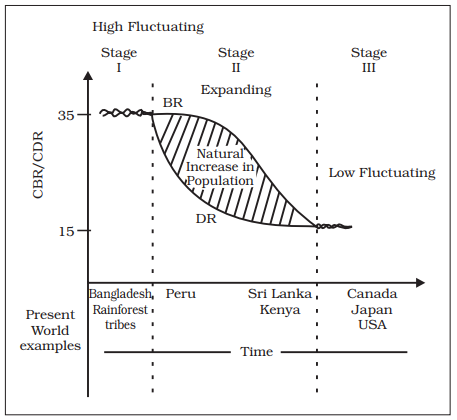-
05 Feb 2024
GS Paper 1
Geography
Day 67: Discuss the three stages of demographic transition. What are the determinants shaping the distribution and population density in India? (250 words)
- Give a brief introduction to the demographic transition.
- Discuss the determinants that shape the distribution and population density in India.
- Conclude suitably.
Introduction
Demographic transition is a concept that explains the evolution of population patterns over time. It typically comprises three stages, each characterized by distinct population trends.
Body
Three Stages of Demographic Transition:
- Stage 1: High Birth Rate and High Death Rate
- In the initial stage, both birth rates and death rates are high, leading to a relatively slow population growth.
- This scenario is often associated with pre-industrial societies, where limited access to healthcare and high infant mortality result in a precarious demographic balance.
- Stage 2: High Birth Rate and Falling Death Rate
- As societies undergo economic development, improvements in healthcare and living standards contribute to a decline in death rates. However, birth rates often remain high, leading to a rapid increase in population.
- This stage is characterized by significant population growth and is commonly observed during the early phases of industrialization.
- Stage 3: Falling Birth Rate and Low Death Rate
- In the advanced stages of demographic transition, birth rates start declining due to factors such as increased education, urbanization, and access to family planning. At the same time, death rates remain low.
- This convergence results in slower but more sustainable population growth, a characteristic feature of developed and industrialized societies.
Determinants Shaping Population Distribution in India:
- Geographical Factors: India's diverse topography, including plains, mountains, and plateaus, influences population distribution.
- For Example, The fertile plains of the Ganges and Brahmaputra rivers are densely populated, whereas hilly and arid regions have lower population densities.
- Climate and Agriculture: Regions with favorable climates and abundant water resources often witness higher population densities. Agricultural productivity plays a significant role, with densely populated areas often coinciding with fertile agricultural land.
- Urbanization: Urban centers attract population due to economic opportunities, better healthcare, and educational facilities. The concentration of industries and services in urban areas contributes to uneven population distribution.
- Infrastructure Development: Accessibility and connectivity impact population distribution. Areas with well-developed transportation networks tend to attract more inhabitants, while remote or inaccessible regions may have lower population densities.
- Political Stability: Political stability or instability can affect population distribution. Regions experiencing political unrest may witness migration patterns as people seek more stable environments.
- Cultural and Social Factors: Cultural practices and social norms can influence population distribution. This includes considerations of caste, class, and ethnicity in the context of population settlements.
Conclusion
The interplay of geographical, economic, and socio-cultural factors underscores the complexity of India's population patterns, highlighting the need for holistic approaches to address demographic challenges and opportunities





